“Saffron Town” Population: 53,000
Old name: Theodoroupolis, Saphrampolis, Zalifre, Taraklıborlu, Gümüş
Favourite son: Sadrazam İzzet Mehmet Paşa (Grand Vizier)
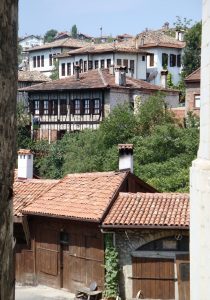 Picture the following. A beautiful town with cobbled streets set amid the hills and full of lovely old Ottoman houses built of wood and covered with pantiled roofs. Next imagine that this same town still nurtures a lively bazaar where saddle-makers and copper-beaters ply their trades. Then consider that it has its own distinctive cuisine, including a particularly tasty form of kebab. The icing on the cake is that the town can be used as a base for exploring several lesser known villages and monuments in the vicinity.
Picture the following. A beautiful town with cobbled streets set amid the hills and full of lovely old Ottoman houses built of wood and covered with pantiled roofs. Next imagine that this same town still nurtures a lively bazaar where saddle-makers and copper-beaters ply their trades. Then consider that it has its own distinctive cuisine, including a particularly tasty form of kebab. The icing on the cake is that the town can be used as a base for exploring several lesser known villages and monuments in the vicinity.
The town in question is, of course, Safranbolu, the “saffron town” that has won UNESCO world heritage site listing for the quality of its intact Ottoman townscape.
The Turks know and love Safranbolu, not least because a visit requires only a short diversion from the main İstanbul to Ankara highway, making it an easy place to get to for a long weekend. Foreign visitors tend not to be quite so familiar with it because many of them are in such a hurry to get from İstanbul to Cappadocia or vice versa that they forget to check out the places along the way. This is a great shame because it means not only that they miss out on seeing a gem of traditional architecture but also on a rare opportunity to put up for the night in true Ottoman style since many of the old houses have now been converted into hotels.
Saffron is still harvested today in the village of Davutobası, 22km east of Safranbolu, although I have not been there myself.
Backstory
Safranbolu’s beauty is a by-product of a 17th-century trade route that used to run north from Gerede to the Black Sea. By the 18th-century the merchants who had prospered the most from this traffic were rich enough to be able to build themselves huge mansions not just in what is now the well-known Çarşı (Market) part of town but also in cooler Bağlar (Vineyards) to which they would retreat in summer to take advantage of its hillside breezes.
Many of these houses still survive, especially in Çarşı, and a visit to one of them offers a remarkable insight into a lifestyle that has gone the way of the camel trains.
Don’t leave town without trying:
- Melt-in-the-mouth kuyu kebabı, baked in a pit oven
- hoşmerim, a thick dessert made from unsalted cheese and semolina
- yaprak helva, a chewy white sweet layered with walnuts
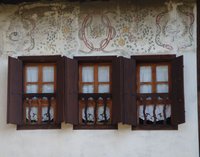 The Safranbolu house
The Safranbolu house
To get an idea of what Safranbolu’s houses were like before their wholesale conversion into hotels you should head straight for the Kaymakamlar Müze Evi (Museum House), the most interesting of the houses open to the public if only because it has been kitted out with mannequins which, while sometimes rather comical, do at least help you imagine the lost lifestyle.
All of them are built out of wood and most soar to three-storeys, with each of the upper floors jutting out above the one below, giving them a slightly top-heavy appearance. Behind sturdy wooden gateways there normally lurks a cobbled courtyard where agricultural equipment could be stored and where the household animals would be stabled – many properties still retain the wooden mangers that used to run along the lower walls, although the more imaginative hoteliers have often converted them into something more suited to a breakfast room or other modern purpose.
Wooden stairs lead up to wide hallways from which the various rooms frequently open off at oblique angles between cushioned sitting areas. The ceilings of the rooms and the central hallways are usually decorated with beautifully carved woodwork focused on a “göbek”, or sunburst ceiling rose. The walls, too, are elaborately carved with niches and cupboards, many of them designed for specific purposes such as storing pipes and tobacco. Not surprisingly given the cold of the Anatolian winter, the focal point of most rooms is often a stone fireplace with a finely carved chimneybreast.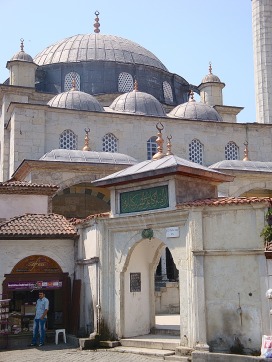 İzzet Mehmet Paşa Cami
İzzet Mehmet Paşa Cami
If the houses open to the public seem curiously devoid of furnishing to western eyes, that’s because the traditional Ottoman lifestyle required little in the way of permanent standing furniture. Instead, sedirs (bench seats) would run around the walls beneath the windows. The family would recline on these during the day, then at night bedding would be brought out from one of the wall cupboards and the sedirs would metamorphose into beds.
Similarly, there were rarely permanent tables in the rooms. Instead, when it was time to eat, tray-style tables would be brought out from the cupboards, and the family and their guests would sit down on the floor around them to eat.
Other distinctive features of Safranbolu houses include huge pools of water, which, to an outsider, look like swimming pools. In fact they were there to cool the rooms and to bring the refreshing sound of running water indoors; even if you don’t plan to stay at the Havuzlu Asmazlar Konağı hotel it’s still worth dropping by to take tea beside the glorious pool that occupies most of its ground floor.
Many of the larger houses also boasted unique “safe boxes”, stone rooms built into the surrounding wooden framework where grain and other valuables could be stored in case of fire. Some of these rooms are so large that they now serve as sitting rooms or bars, as in the superior Gül Evi hotel.
Bathrooms were generally housed inside cupboards.
Aside from the Kaymakamlar Gezi Evi the following houses are also open to the public: Karaüzümler Gezi Evi, Mumtazlar Gezi Evi and Kileciler Gezi Evi.
Around town
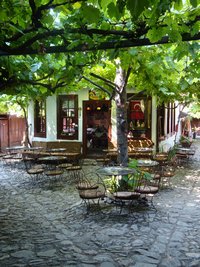 Although the houses are the main reason to visit Safranbolu, it’s also fun to poke about in the bazaar. The most visited part is what was once the Yemeniciler Arastası where leather shoemakers used to work. Today, though, their cute little wooden kiosks mainly tout souvenirs for tourists.
Although the houses are the main reason to visit Safranbolu, it’s also fun to poke about in the bazaar. The most visited part is what was once the Yemeniciler Arastası where leather shoemakers used to work. Today, though, their cute little wooden kiosks mainly tout souvenirs for tourists.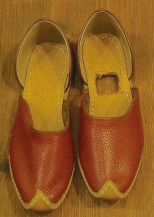 Traditional yemeni shoes
Traditional yemeni shoes
To see Safranbolu’s remaining saddle-makers, copper-beaters and other craftsmen in action you need to wander away from the crowds and explore the back streets to the south of the arasta and near the Akçasu Kanyon.
The excellent Kent Tarihi Müzesi (City History Museum) is housed in what was once the imposing Hükümet Konağı (Goverment Mansion); don’t miss the reconstructed shops in the basement.
Right next to it you can climb the clocktower for magnificent views over the pan-tiled roofs and to inspect the mechanism of a clock made in England some 200 years ago. Then you can wander into what was until recently the Cezaevi (Prison) next door for a very pleasant meal in unusual surroundings.
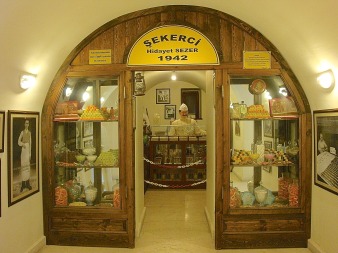 Other sights to look out for include the Cinci Hanı, a massive 17th-century caravanserai right in the town centre, which has been converted into a hotel. Nearby, the Cinci Hamamı (Turkish bath) is certainly worth a visit, although women may have to ask for a masseuse to be summoned to scrub them.
Other sights to look out for include the Cinci Hanı, a massive 17th-century caravanserai right in the town centre, which has been converted into a hotel. Nearby, the Cinci Hamamı (Turkish bath) is certainly worth a visit, although women may have to ask for a masseuse to be summoned to scrub them.
The İzzet Mehmet Paşa Cami, dating back to 1796, is also worth a look as a rare example of a late classical Ottoman mosque in the heart of Anatolia. The grounds contain the grave of İzzet Paşa (1643-1812) who became grand vizer to Sultan Selim III.
The Köprülü Mehmet Paşa Cami dates back to 1661.
Kıranköy
The modern part of Safranbolu is of little interest to tourists except as a place to change buses on the way to Bağlar or the otogar. However, you might want to pop your head inside the Safrantat factory behind the central petrol station to take a look at the way in which Turkish delight (lokum) is made.
A little way back down the hill towards Çarşi on the right the Ulu Cami also turns out to have started life as the 19th-century Greek Orthodox Church of St Stephen, built in 1871 and originally with separate boys and girls schools behind it.
Eating
Safranbolu doesn’t really go in for fine dining and out of season you may struggle to find anything open in Çarşı after 9pm.
One place perhaps worth going out of your way for is the Havuzlu Köşk Et Lokantası over in Bağlar. Like the better known Havuzlu Asmazlar Konağı, this mansion has an indoor pool, this time upstairs, to cool the air. You eat around it in winter or in the garden in summer. Phone first to check that it’s open (Tel: 0370-725 2168).
To try kuyu kebabı you might like to head for the big branch of the Çevrikköprü Tesisleri on the right-hand side of the road as you drive to Yörükköy. The big garden set around a fountain is a plus in summer although it does get very busy with tour groups. There’s a smaller less atmospheric branch back in Çarşı.
Kuyu kebap is also on offer at Kadıoğlu Şehzade Sofrası in Çarşı where you can also try bükme, a spinach-filled covered pide that is a local specialty.
For pudding you might want to try İmren in Çarşı which has a large upstairs sitting area decorated with mannequins in pseudo-Ottoman costumes. It’s a good place to try the jelly-like safranlı zerde, a rice pudding coloured with saffron which is another local delicacy (although don’t believe that it’s necessarily locally grown).
Sleeping
Most people stay in the Çarşı area, but there are more fine mansions up in Bağlar converted from the summer houses owned by wealthier families.
Sadly, some Safranbolu hotels suffer from overly lavish modern decoration and from the attempt to shoehorn too many beds into them to suit Turkish families.
Shoes off please. Aside from the Havuzlu Asmazlar Konağı, Safranbolu’s hotels tend to be run like Turkish homes which means that sometimes you can’t even walk to the reception desk without being expected to remove your shoes and don slippers or galoşes (blue plastic bags, basically). Since this is also the case in the houses open to the public you might want to make sure you’re wearing slip-ons to avoid a great deal of oning and offing.
 Antlers hung on outside wall for good luck
Antlers hung on outside wall for good luck
Akçe Konak, Çarşı. Tel: 0370-725 5000
Çeşmeli Konak The relatively restrained decor of this Çarşı hotel will appeal to those not so keen on crown canopy beds in Ottoman hotels. Ditto the lovely white chimneybreasts. Tel: 0370-725 4455
Cinci Hanı Most of the rooms in this converted caravanserai are fairly small, and some have steps to the lower floor rather too close to the door for children’s safety but if Ottoman style is not your thing this is a good and central Çarşı alternative. In contrast to the standard rooms, the Paşa Odası is simply enormous. Tel: 0370-712 0680
Gökçüoğlu Konağı The enormous and intriguing Gökçüoğlu Konağı in Bağlar retains many typical Safranbolu features such as a revolving serving hatch to move food from the corridor into the dining room without the women being seen. Tel: 0370-712 8153
Gülevi The lovely Gülevi in Çarşi was redesigned by the award-winning architect, İbrahim Canbulat, and features a bar set in what was once the stone-built lock-up for household valuables. Bedrooms come with traditional sedirs and fireplaces; the beds are set low to be unintrusive in keeping with the fact that there were no standing beds in Ottoman houses. Tel: 0370-725 4645
Havuzlu Asmazlar Konağı Finest of all Safranbolu’s places to stay is the Havuzlu Asmazlar Konağı in Çarşı, beautifully restored under Çelik Gülersoy’s supervision and with a wonderful pool in the breakfast room so that the sound of refreshing running water could soothe the residents’ fevered brows in summer. Tel: 0370-725 2883
Mehveş Hanım Konağı Set in a lovely garden, this typical konak has huge rooms with creaky floorboards that would be perfect were the furnishings just a little more in keeping with the Ottoman architecture. Breakfast is taken in the ground-floor dining room. Tel: 0370-712 8787
Selvili Köşk This long-lived hotel in Çarşı has one of the finest top-floor communal sitting areas. Tel: 0370-712 8646
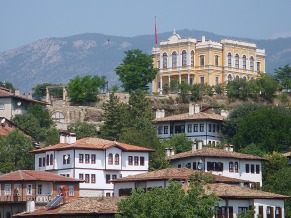 The yellow Hükümet Konağı building houses the City History MuseumTransport info
The yellow Hükümet Konağı building houses the City History MuseumTransport info
The authorities don’t go out of their way make things easy for visitors who arrive by public transport. Although there are a few direct bus services to Safranbolu from İstanbul and Ankara usually you have to change to a servis bus in Karabük. This will probably take you the 9km to Safranbolu bus station whence you take another servis to Kıranköy, the centre of modern Safranbolu, and then a local bus down to Çarşı or up to Bağlar.
To get to Bağlar, 2km west from Çarşı you will need to return to Kıranköy and swap to another bus.
There is no direct public transport to Yörükköy, İncekaya or Bulak Mencilis Mağarası (cave) but taxi drivers in Safranbolu will negotiate a return trip fare to include waiting time.
When you want to leave you should be able to buy a ticket from one of the bus company offices clustered around the main road junction in Kıranköy rather than going all the way back to the otogar.
Day trip destinations
Davutobası
İncekaya Su Kemeri
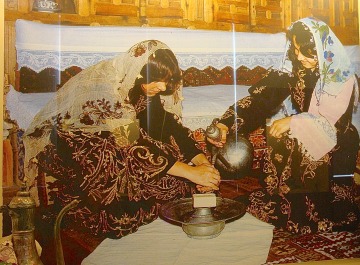 Lovely old Ottoman dress of Safranbolu
Lovely old Ottoman dress of Safranbolu

